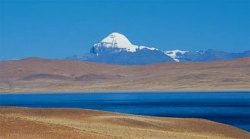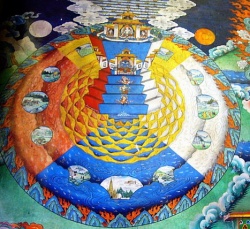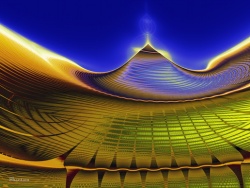Mount Kailas and Lake Manasarovar
Mount Kailas: since time immemorial, most of the people of the East have believed that somewhere in the Himalayan massif, between China and India, stood a sacred mountain: the navel of the earth, the axis of the universe. From its summit flowed a mighty river which fell into a lake, from which stemmed the great rivers of Asia. This was the holiest of mountains, revered by Hindus, Buddhists and Jains as the home of their gods. In metaphysical terms it was Meru or Tise; in its earthly manifestation it was Kailas, the crystal, or Kang Rinpoche, jewel of the snows. The swastika mountain.
Moyra was here
"As the dew is dried up by the morning sun so are the sins of men dried up by the sight of the Himalaya, where Shiva lived and where the Ganga falls from the foot of Vishnu like the slender thread of a lotus flower. There are no mountains like the Himalaya, for in them are Kailas and Manasarovar." From the Skanda Purana.
Moyra was here
In Tibetan mythology, the Chang Tang plateau lay submerged under a great lake, long before the advent of man; then a compassionate Bodhisattva cut an outlet through the Himalayas for Tibet's 'great river', the Tsangpo.
The Mongol people migrated en masse into the Tibetan plateau area about two thousand years ago.
The Aryans, migrating into India, called the Himalayas the 'abode of snow': Himavant, Himachala or Himalaya; in their cosmography, the core of the universe was mount Meru, that of the 'blazing appearance' - situated beyond and to the north of the Himalaya ranges - according to the Hindu epic Mahabharata 'kissing the heavens by its height, shining like the morning sun and like a fire without smoke, immeasurable and unapproachable by men of manifold sins'. On the summit of Meru stood Swarga, heavenly city of Indra (the Vedic god of rain and storm) - a paradise 'furnished with heavenly flowers and fruit and covered everywhere with bright gold dwellings'. The greatest gods dwelt in this city; lesser gods and saints had to be content with palaces further down the mountainside. Leading up to Meru itself was the pathway of the stars, a never-never land of fragrant trees and flowers where the souls of the dead awaited rebirth. Now, the Mahabharata and its stodgier cousin, the Ramayana, are dated to about 500 BC; in them appears also mention of mount Kailas (then a lesser holy mountain not associated with Meru) and also a lake called Manasarovar appears in a line of the Ramayana ie 'the lake Manasa ... swollen with water on the arrival of the rains'.
As the Aryans pushed into India, they began to settle around the vital river Ganga (whose shores, in the present day, shelter a third of India's population). They celebrated the divinity of this vital river in the form of a mother goddess, Ganga Mai, daughter of the Himalayas; to die by her banks and be cast into her muddy waters was to be delivered direct to Heaven; even to dip oneself three times under her surface was to be cleansed of all sins, emerging reborn. Thus the believer, even now, comes down to the Ganga soon after dawn, and immersing himself fully three times, cups his hands and three times offers water to the rising sun. And he chants the prayer of the seven sacred rivers of India:
Gange cha! Yamune chiava! Godaveri!
Saraswati! Namade! Sindhu! Kaveri!
Jale asmin sannidhim kuru!
Or: O Ganga! O Jumna! Godaveri!
Saraswati! Namade! Indus! Kaveri!
May you all be pleased to be manifest in these waters!
Moyra was here
Hindu ascetics, upon casting off the affairs of the earth, become the sanyasi: the pilgrim who roams from one place to another seeking final absorption into the Ultimate. They shave off their hair and beards, conduct their own funeral ceremonies and take on pale ochre robes symbolizing rebirth through the flames of the funeral pyre. Those who seek the holy places of the Himalayas begin their pilgrimage at Ganga-dwara, the gateway of Ganga - the narrow break in the Siwalik foothills through which the Ganges poured forth into the plains of India. Beyond this gateway lies Uttarakhand the northern country, Kedarkhand Shiva's county: the holy land of the Hindus, where every peak had its deity, every valley its temple and every spring its shrine.
The Puranas (eighteen holy texts composed between 200 BC and 800 AD) give a description of the world. This the earth is made up of seven continents, ringed by seven oceans. The central land has as its heart Meru, and this the centrepoint of the world-mandala is bounded by three mountain ranges to the north and three more to the south, itself lying between them like the pericarp of a lotus. The Indian subcontinent is called by the name Bharatha. The world-pillar Meru stands eighty-four thousand leagues high, its four faces being variously of crystal, ruby, gold and lapis lazuli. From the nail of the great toe of Vishnu's left foot flows the Ganga, washing clean the face of the moon ere it pours down upon the summit of Meru; the stream circles the mountain and divides into four mighty rivers flowing to the four quarters of the earth: the Sita, Alaknanda, Chaksu and Badra. The Sita flows east through the country of Bhadrashva to the ocean; the Alaknanda flows south through Bharatha (India) dividing into seven as it does, and falls into the sea; the Chaksu flows west through mountains and the country of Ketumala into the sea; and finally the Badra washes the country of the Uttara Kurus and empties itself into the northern ocean. This image or map forms the Buddhist mandala and the Hindu version of the same, the yaanta. Thus the mystic meditates upon the balance of the circle, water, with the square, earth: these are Taoist yin and yang, the Tibetan tantric yab and yum, or the Shaivite tantric Shiva-Shakti.
Moyra was here
Black belief: old shamanistic religion of Bon-Po. According to old Bon texts, the nine-story swastika mountain (Mt. Kailas) the heart of their religion, had to be moved to its present site from NE Tibet. In a Tibetan (ie Bon-Po) text of uncertain origin, called the Kangri Karchhak (Ice-Mountain Guide) it is stated that a stream flows down from Tise into the lake Mapham Tso (unconquerable lake) from which lake emerges four rivers. These four rivers circle the lake seven times before taking their courses west, east, north and south. The first river is the Senge-Khambab, the lion-mouth river, rich in the sands of diamonds, whose waters flow north and make those who drink from it brave as lions. The second river is the peacock-mouth river, the Mapchhu-Khambab, rich in silver sands, whose southward-flowing waters make all who drink therein lovely as peacocks. The third, flowing east, is the horse-mouth river or Tamchok-Khambab, emerald of sands, whose waters make those who drink as sturdy as horses. And the westward river is the Lanchen-Khambab, the elephant-mouth river, with sands of gold and waters that make those who drink it strong as elephants.
Moyra was here
And in the early Chinese geographical text Ta-T'ang-Hsi-Yu-Chi (Records of the Western World, compiled during the T'ang Dynasty, AD 618-907), is this account:
"The mountain called Sumeru stands up in the midst of the great sea firmly fixed on a circle of gold, around which mountain the sun and moon revolve. This mountain is perfected by four precious substances and is the abode of the Devas <gods>. Around this are seven mountain ranges and seven seas.
"In the middle of Shan-pu-chao <the central continent> there is a lake called Wo-jo-nao-chih, to the south of the fragrant and to the north of the great snowy mountains. It is 800 li and more in circuit, its sides are composed of gold, silver, lapis lazuli and crystal. Golden sands lie at the bottom and its waters as clear as a mirror. The great earthly Bodhisattva transforms himself into a Naga-raja <snake divinity> and dwells therein; from his dwelling the cool waters proceed forth and enrich Shan-pu-chao."
As to be expected, from this central fons de origo the four rivers issue forth: the Kan-chieh or Ganga from the mouth of a silver ox; the Hsin-tu or Sindhu from the mouth of a golden elephant; the Hsi-to or Sita from the mouth of a crystal lion and the Fu-chu or Vakshu from the mouth of a horse of lapis lazuli. Actually, in a map published in a Japanese encyclopedia in 1714, the world-hub lies north of the Kailas range: from it, the four rivers spiral out, feeding into Manasarovar and thence branching into virtually every conceivable watercourse including the Oxus and Yangtze.
Moyra was here
At the time of the T'ang Dynasty, Buddhism was just beginning to gain a foothold in Tibet; eventually, though, about the thirteenth century the lamastic faith had become ascendent over Bon country of Western Tibet. This conquest is told of in the tale of a famous duel fought for possession of the holy mountain itself, between the yogi Milarepa (champion of tantric Buddhism) and Naro-Bonchung, the champion of shamanism. According to some versions, Naro-Bonchung was aided by his sister, a sorcercess who had lengthened her own life by occult means. In any case, the two great magicians fought long and hard, finally agreeing that whoever reached the summit of Kang Rinpoche first at dawn the next day would be the winner. At sunrise, Milarepa's disciples were perturbed to see how their master sat meditating while the Bon shaman soared up the mountainside mounted upon his magic drum. Yet still at the last moment, Milarepa flew up into the air, overtook the Bon-Po and won the mountain for Buddha. And the vertical gash down the south face of Kailas is said to have been dug out by Naro-Bonchung's drum - dropped by him in his alarm at seeing the lama overtaking him.
(Modern versions of this legend place the scene of battle at Mount Everest.)
Moyra was here
Bibliography:
A Mountain in Tibet by Charles Allen.
The Myth of Shangri-La by Peter Bishop.





